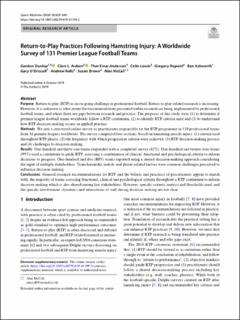| dc.contributor.author | Dunlop, Gordon | |
| dc.contributor.author | Ardern, Clare L. | |
| dc.contributor.author | Andersen, Thor Einar | |
| dc.contributor.author | Lewin, Colin | |
| dc.contributor.author | Dupont, Gregory | |
| dc.contributor.author | Ashworth, Ben | |
| dc.contributor.author | O'Driscoll, Gary | |
| dc.contributor.author | Rolls, Andrew | |
| dc.contributor.author | Brown, Susan | |
| dc.contributor.author | McCall, Alan | |
| dc.date.accessioned | 2020-05-12T08:46:25Z | |
| dc.date.available | 2020-05-12T08:46:25Z | |
| dc.date.created | 2020-01-28T10:54:27Z | |
| dc.date.issued | 2019 | |
| dc.identifier.citation | Sports Medicine. 2019, 50(4), 829–840. | en_US |
| dc.identifier.issn | 0112-1642 | |
| dc.identifier.uri | https://hdl.handle.net/11250/2654014 | |
| dc.description | This article is distributed under the terms of the Creative Commons Attribution 4.0 International License (http://creativeco
mmons.org/licenses/by/4.0/), which permits unrestricted use, distribution, and reproduction in any medium, provided you give appropriate credit to the original author(s) and the source, provide a link to the Creative Commons license, and indicate if changes were made. | en_US |
| dc.description.abstract | Purpose: Return-to-play (RTP) is an on-going challenge in professional football. Return-to-play related research is increasing. However, it is unknown to what extent the recommendations presented within research are being implemented by professional football teams, and where there are gaps between research and practice. The purposes of this study were (1) to determine if premier-league football teams worldwide follow a RTP continuum, (2) to identify RTP criteria used and (3) to understand how RTP decision-making occurs in applied practice. Methods: We sent a structured online survey to practitioners responsible for the RTP programme in 310 professional teams from 34 premier-leagues worldwide. The survey comprised four sections, based on hamstring muscle injury: (1) criteria used throughout RTP phases, (2) the frequency with which progression criteria were achieved, (3) RTP decision-making process and (4) challenges to decision-making. Results: One-hundred and thirty-one teams responded with a completed survey (42%). One-hundred and twenty-four teams (95%) used a continuum to guide RTP, assessing a combination of clinical, functional and psychological criteria to inform decisions to progress. One-hundred and five (80%) teams reported using a shared decision-making approach considering the input of multiple stakeholders. Team hierarchy, match- and player-related factors were common challenges perceived to influence decision-making. Conclusions: General research recommendations for RTP and the beliefs and practices of practitioners appear to match with, the majority of teams assessing functional, clinical and psychological criteria throughout a RTP continuum to inform decision-making which is also shared among key stakeholders. However, specific criteria, metrics and thresholds used, and the specific involvement, dynamics and interactions of staff during decision-making are not clear. | en_US |
| dc.language.iso | eng | en_US |
| dc.subject | professional football | en_US |
| dc.subject | psychological readiness | en_US |
| dc.subject | prevention strategies | en_US |
| dc.subject | risk factors | en_US |
| dc.subject | re-injury | en_US |
| dc.subject | sport | en_US |
| dc.subject | criteria | en_US |
| dc.subject | soccer | en_US |
| dc.subject | rehabilitation | en_US |
| dc.subject | perceptions | en_US |
| dc.title | Return-to-Play Practices Following Hamstring Injury: A Worldwide Survey of 131 Premier League Football Teams | en_US |
| dc.type | Peer reviewed | en_US |
| dc.type | Journal article | en_US |
| dc.description.version | publishedVersion | en_US |
| dc.source.pagenumber | 829–840 | en_US |
| dc.source.journal | Sports Medicine | en_US |
| dc.identifier.doi | 10.1007/s40279-019-01199-2 | |
| dc.identifier.cristin | 1783829 | |
| dc.description.localcode | Seksjon for idrettsmedisinske fag / Department of Sports Medicine | en_US |
| cristin.ispublished | true | |
| cristin.fulltext | original | |
| cristin.qualitycode | 1 | |
